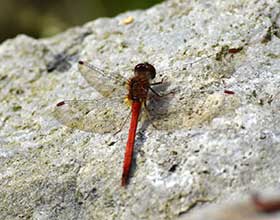 For any animal, the temperature of its body matters. Bodily functions depend on chemical processes that are temperature-sensitive and on enzymes whose functions vary with temperature. For many simple systems, chemical reactions proceed more quickly at higher temperatures. For biological systems, though, and particularly for proteins like enzymes, functionality typically peaks at some relatively narrow range of temperatures and falls off above and below. That translates directly to functionality of animal body systems.
For any animal, the temperature of its body matters. Bodily functions depend on chemical processes that are temperature-sensitive and on enzymes whose functions vary with temperature. For many simple systems, chemical reactions proceed more quickly at higher temperatures. For biological systems, though, and particularly for proteins like enzymes, functionality typically peaks at some relatively narrow range of temperatures and falls off above and below. That translates directly to functionality of animal body systems.
For dragonflies, critical functions like digestion, vision, flight, and prey capture all are most effective at some optimal range of body temperatures. Peak functionality commonly occurs at temperatures around 30 – 35oC (85 – 95oF), not much different from typical mammalian, including human, body temperature. Temperatures that warm are easiest for an insect to achieve during warm weather, and in Ohio, both the abundance and the diversity of dragonflies peaks in June and July.
Nevertheless, dragonflies appear on the landscape in Ohio as early as March, and the last dragonflies of the year are out and about until late November. Meadowhawk dragonflies from the genus Sympetrum —a group of smallish species, mostly with bright red bodies in males –occur at both ends of that seasonal spectrum. In early spring, variegated meadowhawks (Sympetrum corruptum) migrate into Ohio from more southern states. Autumn meadowhawks, Sympetrum vicinum, emerge later in the year and typically remain active well into November, later than any other species. In the months between those extremes, several other meadowhawk species, including band-winged (Sympetrum semicinctum), ruby (S. rubicundulum), and blue-faced (S. ambiguum), appear and then depart the landscape.
Given that broad seasonal occurrence, meadowhawks clearly must be able to function across a range of environmental temperatures. How do they do it? One possibility is that different meadowhawks operate at different optimal body temperatures. For example, cool-season species might function with cooler bodies. That is somewhat true, but the differences are relatively minor. Moreover, all of the species prefer body temperatures warmer than usual air temperatures during their active seasons in Ohio.
A second possibility is that meadowhawks have ways to regulate the temperatures of their bodies. In particular, given their preferences for warm bodies, meadowhawks must be able, somehow, to warm themselves. How do they do so?
Animals fall into two major categories with respect to strategies for body warming. In some species—endotherms—the animal has a high enough rate of metabolism to generate body-warming heat. In contrast, species lacking that high rate of metabolism must rely on the environment to get warm. For those species—ectotherms—behaviors like basking in the sun are key. The vast majority of insects, like almost all animals other than birds and mammals, are ectotherms. The exceptions—the endothermic insects—are typically large, stout-bodied, and furry, like some species of bees, moths, and beetles, so that they can effectively retain the heat they generate. Sympetrum dragonflies, which are small, skinny, and hairless, seem like bad candidates for endothermy.
It turns out that the mechanism of body temperature regulation has been studied for just a couple of meadowhawk species, including one that occurs in Ohio, the autumn meadowhawk, and one from Europe, the common darter Sympetrum striolatum. As expected, autumn meadowhawks are ectotherms. They do function at slightly lower body temperatures than a lot of dragonflies, but it’s still critical for them to warm up by basking in the sun. Indeed, the genus name “Sympetrum” literally means “with rocks,” reflecting their habit of basking on rocks. Like most Sympetrum dragonflies, autumn meadowhawks are “perchers”; they fly just short distances to catch prey before resettling on a perch. So, the habit of basking fits their general lifestyle.
On the other hand, common darters offer a surprise. These dragonflies do bask as part of their warm-up strategy. But it turns out that they also are capable of endothermy. They accomplish that by “whirring” their wings, rapidly contracting their thoracic muscles in much the same way as mammals shiver. Once those thoracic muscles are warm, they can effectively power flight. Most likely, wing whirring is accompanied by some mechanism to restrict blood from flowing out of the thorax, so that heat is retained there rather than radiated away from the abdomen.
At this point, we can only speculate about how body temperature is regulated in Ohio’s other Sympetrum species. However, the comparison of autumn meadowhawks vs. common darters may be informative. As noted above, autumn meadowhawks are “perchers” and make just brief, short flights. In contrast, common darters sometimes migrate long distances, and endothermy may have evolved to support the vigorous flight required for those migrations. In Ohio, variegated meadowhawks engage in early spring migratory flights and as such may be candidates for endothermy. Our other meadowhawk species all are perchers, and it seems likely that they are ectotherms. Only further study will confirm that speculation. In the meantime, meadowhawks are little gems of local meadows and wetlands. Autumn meadowhawks are the species of meadowhawk seen most commonly in Ohio, and they are nearly the only kind of dragonfly still active in November. Keep an eye out for them!
Article and photo contributed by Dr. David L. Goldstein, Emeritus Professor, Department of Biological Sciences, Wright State University.
